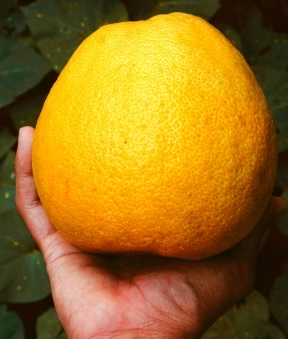Mid-Autumn Festival is approaching, and every household in China enjoys pomelo. How should one choose a pomelo, and what are its nutritional values?
Guidelines for Choosing a Pomelos
- Round Shape: Well-grown pomeloes are typically wide at the base and slightly tapered at the top, creating a symmetrical, rounded shape with a hint of triangular pyramidal styling. Those that are elongated are generally less sweet.
- Yellowish Color: Generally, pomeloes can be identified by their color. Emerald green pomeloes are typically fresher, but not at their peak. They are generally best enjoyed one to two weeks after being picked, when the color changes from green to yellow.
However, some yellow-skinned pomeloes may appear dehydrated and wrinkled. Don’t be put off by this; it means the flesh inside has softened from its hard texture, revealing its sweetness.
- Smooth Skin: The skin of a pomelo is dotted with oil spots, called “oil cells.” Pomeloes with finer oil cells and a smoother skin tend to taste better than those with thicker skin and more visible oil cells.
- Weight is paramount. Weigh the fruit in your hand. Heavier ones typically contain more water, have better-developed flesh, and are less dry and astringent.
- Choosing Pomelo Size is a Myth: Consumers generally believe that smaller pomeloes are sweeter. The taste of a pomelo is no longer directly related to its size; instead, the cultivation techniques of the grower have a greater influence. In other words, even large pomeloes produced by skilled growers will be just as delicious.
Friendly reminder: Remember to wash your hands after peeling a grapefruit.
Grapefruit peel contains plant compounds like urushiol, which can metabolize the sebum film on the skin’s surface. Exposure to sunlight or ultraviolet light from fluorescent tubes can cause pigmentation, which typically takes 2-3 months to fade. It’s recommended to wash your hands after peeling the grapefruit, especially your palms and arms.
Are grapefruits high in calories?
Grapefruits are rich in vitamin C, containing 54.5 mg per 100 grams, 1.5 times more than lemons. Vitamin C acts as an antioxidant, prevents pigmentation, and repairs body tissues.
There’s also a common misconception that grapefruit is high in calories. However, one grapefruit weighs about 500-600 grams, and each 100 grams contains only 33 calories. Eating a whole grapefruit at once only provides about 200 calories, roughly the same as a full day’s worth of fruit. If you don’t eat more than one, it’s actually fine.
From a Traditional Chinese Medicine (TCM) perspective, grapefruit pulp has the benefits of regulating qi and resolving phlegm, moistening the lungs and clearing the intestines, nourishing the blood and strengthening the spleen, and stimulating the appetite. Grapefruit is suitable for people with coughs that produce thick phlegm, constipation, indigestion, hot flashes, and poor appetite.
However, those with excessive stomach acid or gastroesophageal reflux should limit their consumption. Furthermore, because grapefruit has a cold nature, those with a predisposed constitution to diarrhea should not consume too much.
It is important to note that because most pomelo and grapefruit contain furanocoumarin, it can inhibit the body’s metabolism of certain drugs (antihypertensive, antilipidemic, antiarrhythmic, immunosuppressive, some hypnotics and antidepressants), causing the drugs to stay in the body for a longer time and at too high a concentration. Those who need related medications must pay special attention.


Leave a Reply